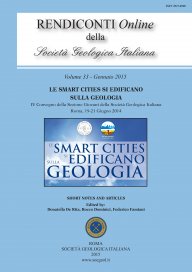
L'impatto antropico sul sistema costiero di Santa Maria di Ricadi (Calabria sud occidentale)
Alessia Tavella (*), Paola Basta (**) & Domenico Modaffari (***)
(*) Dipartimento di Biologia, Ecologia e Scienze della Terra, Università della Calabria. E-mail: alessia_tav@yahoo.it
(**) Libero professionista, Marano Marchesato (CS).
(***) Centro Cartografico Regionale, Servizio di Interoperabilità e di Rete per la Cartografia e Sito, Dipartimento Urbanistica e Governo del territorio, Regione Calabria.
Volume: 33/2015
Pages: 96-99
Abstract
The Calabrian coast is the landscape element of greater economic importance as it is one of the few voices of regional GDP continues to grow.
The coastal area of Santa Maria di Tropea (VV) is the landscape element is based on the tourism area which receives 20% of tourists of the Calabria region and more than 50% of the foreign ones.
The multi-temporal analysis of dynamic elements using GIS (beach, river network and land use) and non-convertible (geology, morphology) is a tool for investigation of the evolution of the landscape highlighting critical issues and relations of cause and effect.
The elements of the coastal landscape were analyzed using GIS through the use of integrated and comprehensive bibliographic data and relating to the interpretation of satellite and aerial images (Calabria Region, regional mapping and Geographic Information System) from 1954 to 1998 and 1998 to 2008.
The area of the study covers 5 km2 and is characterized by a substrate plutonic (tonalite) covered by a sedimentary sequence I-Pliocene deposits of terrace sandy-conglomeratic. The area is characterized by terraced areas to a torrential river network and a coastline with two pocket beaches and Santa Maria Grotticelle.
The urban areas in the period 1954-1998 increased from 0.044 km2 to 1.2 km2 obliterating the dune system and partly the backshore. Between 1998-2008 there was an increase in the area of Santa Maria of about 0.2 km2 (total 1.4 km2).
This increase in urban areas is associated with a retreat of the shoreline. Between 1998 and 1958 in the area of Santa Maria there is a loss of backshore equal to 5,998 m2 and 12,204 m2 between 2008 and 1998. In Grotticelle there is instead a small increase of 635 m2.
The total length of the river network in 1958 stood at 9.2 km which decreases to 4.8 km due to heavy urbanization.
The growing urbanization of the area of Santa Maria di Tropea is one of the main causes of the decrease in the emerged beach and especially the reduction of the power systems of the coastal system. This analysis allows us to highlight how land use planning aimed at the growth of tourism has triggered and/or amplified erosion processes, determining conditions of landslide risk and coastal environment and the loss of the economic value of the resource landscape.
In this context there is a clear need for structural which must be associated with actions of planning, restoring the equilibrium of the coastal system and management of the resource landscape through choices of sustainable tourism development is also necessary.
Keywords
Get Full Text